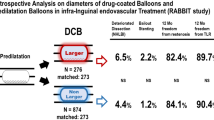Abstract.
Coronary stent implantation is currently performed in > 80% of percutaneous coronary interventions. Its main late complication is the development of in-stent restenosis (ISR), occurring in 10–80% of lesions treated in daily practice. The classification by Mehran et al. is most commonly used. Current therapeutic options to treat ISR include repeat balloon angioplasty, repeat stenting, cutting balloon angioplasty, directional coronary atherectomy, rotational coronary atherectomy, brachytherapy, and drug-eluting stents (DES). DES have been effective in reducing binary restenosis in de novo lesions in randomized controlled trials. The novel use of DES to treat ISR has been shown to be safe and effective in multiple studies involving sirolimus- and paclitaxel-eluting stents. As DES implantation becomes more widespread, ISR in DES is emerging as a new problem. The use of debulking techniques to treat ISR in DES is to be cautioned against. In this new era, the optimal treatment of this new problem is currently unknown. We await further data to see whether repeat DES implantation may help solve this vexing clinical problem.
Zusammenfassung.
Bei Koronarinterventionen wird heute in über 80% eine Stentimplantation vorgenommen. Unter Alltagsbedingungen ist ihre häufigste Spätkomplikation die Entwicklung einer In-Stent-Restenose (ISR) in 10–80%. Die Klassifikation der ISR erfolgt meist nach Mehran et al. Die gegenwärtigen Behandlungsmöglichkeiten der ISR umfassen die erneute Ballonangioplastie, erneutes Stenting, den Cutting balloon, die direkte Atherektomie, die Rotablation, die Brachytherapie und die Medikamente freisetzenden Stents (DES). In randomisierten Studien haben DES ihre Wirksamkeit in der Reduktion der binären Restenoserate bei De-novo-Stenosen bewiesen. In multiplen (nicht randomisierten) Studen hat der Einsatz von Sirolimus- und Paclitaxel-DES seine Sicherheit und Wirksamkeit auch bei der Behandlung der ISR gezeigt. Die Verwendung von DES in ISR führen zu einem neuen Problem: Der Einsatz von ablativen Verfahren zur Behandlung der ISR nach DES sollte mit Bedacht geschehen. Die optimale Behandlung der ISR nach DES ist unklar. Mehr Daten zum Einsatz einer erneuten Implantation von DES bei ISR nach DES werden zeigen, ob dieses lästige Problem gelöst werden kann.
Similar content being viewed by others
Author information
Authors and Affiliations
Corresponding author
Rights and permissions
About this article
Cite this article
Ong, A.T.L., Aoki, J., McFadden, E.P. et al. Classification and Current Treatment Options of In-Stent Restenosis. Herz 29, 187–194 (2004). https://doi.org/10.1007/s00059-004-2574-4
Issue Date:
DOI: https://doi.org/10.1007/s00059-004-2574-4




